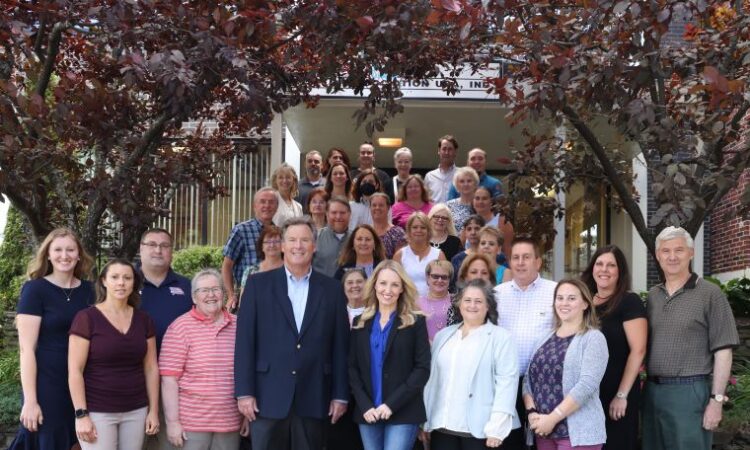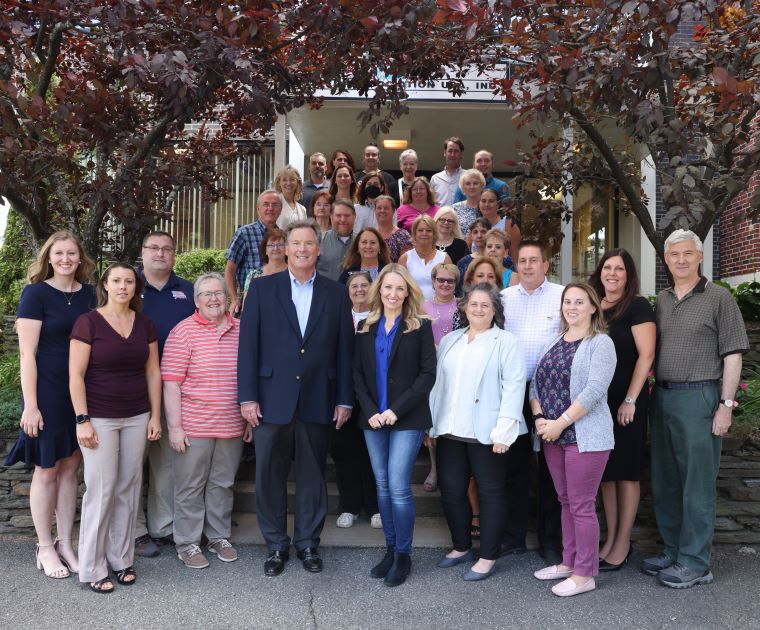

Pictured are some of the Holstein Association USA staff members in front of the office in downtown Brattleboro, along with Holstein America host Michelle Davidson.
by Joyce Marcel, Vermont Business Magazine The Holstein is the perfect cow, says the Holstein Association USA, Inc the nonprofit membership organization that has anchored the south end of Main Street in Brattleboro since 1903.
There are Holstein Associations in other countries throughout the world. Holstein Association USA is a member of the World Holstein Friesian Federation. However, the U.S. is generally recognized by other countries as having sought-after Holstein genetics.
“The Holstein cow is able to eat things that we as humans, can’t eat,” enthused Emily Annexstad, the Holstein Association’s marketing and communications manager. “She can eat grass, corn stalks, corn silage, and all those things. And she can convert it into extremely nutritious and delicious foods that we can eat like milk, cheese and yogurt. The Holstein cow can produce more pounds of milk with high components of butterfat and protein more efficiently than any other breed of dairy cattle or any other animal. She is amazing.”
The association, which has been in Brattleboro for 137 years, is dedicated to managing the genetics and improving the profitability of the Holstein cow.
They like to say they’re “The Ancestry.com for Holsteins.”
“We provide, in a nutshell, programs and products and services to help dairy farmers be more successful,” said CEO/Executive Secretary John Meyer. “The base of our business is really ancestry. People like to know the family trees, the genetics, of their cows. It’s much like people wanting to know their own family tree. I’ve said many times that most of our members know the family trees of their cows better than many of us know our own personal family trees.”
Many associations members have several generations of a cow family in their herd.
“Somebody might have, for example, the matriarch of a cow family whose name might be Joyce,” Meyer said. “A lot of times, they’ll keep the ‘J’ theme. So Joyce’s offspring might be called Julie, and Julie’s might be called Jessica, and Jessica might be called Jane. The genetics are important. They develop their herds based on that kind of information. So we provide dairy farmers with identification services, like ear tags, so they can they can identify and track those animals.”
The association provides each purebred Holstein with an ID number that works like a social security number, identifying them throughout their life.
The distinctive Holstein was first created by migrant European tribes who settled in the Netherlands about 2,000 years ago. They bred the black cattle of the Batavians with the white cows of the Friesians; the offspring were culled to produce animals that gave the most milk under limited feed conditions. Eventually they evolved into the cow we know and love today.
The first Holstein came to the United States in 1631 (the Mayflower arrived in 1620), but its bloodlines were lost to interbreeding. Then, in 1861, one came on a ship— it was used to provide milk for the crew on the long journey. Its American buyer was so pleased with its milk production that he imported more. By the late 1800s there were enough Holsteins here and enough interest in the breed to form associations; in 1885 the Holstein-Friesian Association was formed. (They dropped the name Friesian in 1994.)
In 1894, the organization’s second secretary set up offices at his farm in Putney, and there you have the answer to the question: “Why Brattleboro?”
The Holstein Association’s revenues for 2022 are estimated to be $18.3 million (#86 Vermont 100+).
The Holstein Assoc. does more than protect the cow’s profitability; it also protects the host town.
“I think we’re the oldest, longest continuously operated business in downtown Brattleboro,” Meyer said. “We built this building in the early 1900s, and have anchored this portion of downtown Brattleboro ever since that time. We bring a lot of visitors to Brattleboro every year from all over the world. We are a great customer of hotels and restaurants in the area. Our visitors enjoy going downtown and buying different things.”
Since the association is the repository of the Holstein genetic base, it is in contact with farmers from all over the United States.
“And every day, monies are coming into Brattleboro, Vermont, from all over the country,” Meyer said. “Whether that be California, Florida, Wisconsin, or Oklahoma, you name it. So that’s an influx of new money into Brattleboro. Then, the people who work here get paid every two weeks from that money, and they spend it locally. And of course, the people who work here pay taxes. So we’ve been a big part of Brattleboro for a long, long time.”
The association now employs over 100 people in the office and the field.
“I think another really unique thing is the number of people since the early 1900s who have worked for the association at one point or the other,” Mayer said. “There are so many families from Brattleboro who have had a family member work here at some point in their life.”
Other bovine breeds have institutions like the Holstein Association.
“And we provide some services for those other breeds as well,” Meyer said. “We do work for the, the American Guernsey Association and the Cattle Breeders Association and the American Milking Shorthorn Association and, and we’ll probably be doing some work for other people soon as well.”






